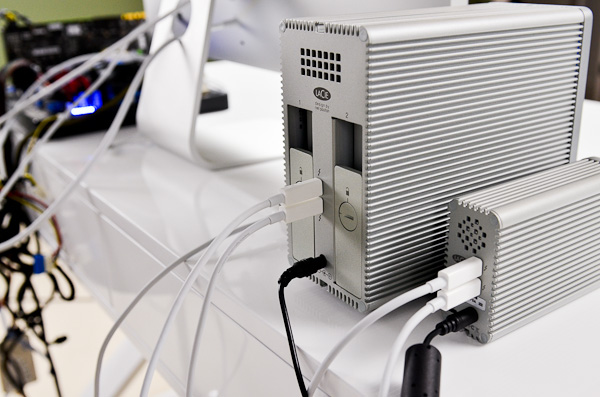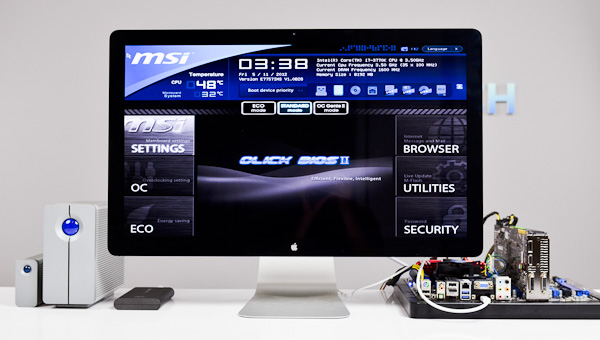A First Look at Thunderbolt on Windows with MSI's Z77A-GD80
by Anand Lal Shimpi on May 11, 2012 1:32 PM EST- Posted in
- Motherboards
- CPUs
- Intel
- MSI
- Thunderbolt
The Storage Devices & Performance
Other than Apple's Thunderbolt Display, every other TB device we've tested has been some sort of storage device. In my lab I've got Promise's Pegasus R6, LaCie's 2big and Little Big Disk (SSD), Seagate's GoFlex Thunderbolt adapter and Elgato's Thunderbolt SSD. With the exception of the Pegasus R6, which currently lacks Windows drivers, all of the storage devices I tested worked with MSI's Z77A-GD80 under Windows. Although there are workarounds for getting the Pegasus up and running under Windows, I encountered a number of hangs and general system unhappiness whenever I tried them on this platform. I suspect this has something to do with why Promise has yet to officially release Windows drivers for the Pegasus.
The rest of the storage devices, as you would expect, just worked. I didn't need to install any drivers as all of their internal controllers had native support under Windows 7. Again, I couldn't hot plug any of these devices once Windows was running - all of them had to be present at boot.
Just as I've seen under OS X, with complex Thunderbolt chains you'll sometimes have a device that hangs in the chain and prevents some or all TB devices from working. I did encounter this behavior more frequently under Windows than I did under OS X. Keep in mind that every single Thunderbolt device on the market today was pretty much developed and tested against Macs, it's going to be a little while before we get perfect behavior under Windows. We don't even have perfect behavior under OS X yet either. My hope is that as more platforms ship with Thunderbolt support, and as we get more Thunderbolt devices, compatibility and behavior validation will both improve. I've also heard that the early Thunderbolt controllers were more finicky than Cactus Ridge, so it's possible that newer TB devices that come out this year will just inherently be better behaved. This is purely hearsay however, I don't have any hard evidence to back it up.
Update: Intel tells us that an updated Pegasus driver is in the works that will address the issues we've seen. Other finicky behavior is also expected to be addressed through the Thunderbolt on Windows certification process.
Since I couldn't get the Pegasus working, I had to resort to combining a bunch of my other Thunderbolt storage devices to measure performance. I created a chain combining LaCie's 2big, the SSD Little Big Disk and Elgato's Thunderbolt SSD along with Apple's Thunderbolt Display. I ran a 128KB sequential read test at a queue depth of 32 across all of the drives, while pushing the Thunderbolt Display at its native 2560 x 1440 resolution:
The best I ever got under OS X was 8Gbps using four SandForce SSDs in the Promise Pegasus. At 7Gbps using a far less elegant setup, this isn't bad at all. Keep in mind that while we're reading at 7Gbps, the GD80 was also using around 7Gbps of bandwidth to drive the Thunderbolt Display at 2560 x 1440. Total available bandwidth for a single-port Thunderbolt device is 20Gbps bi-directional (40Gbps total), so there's still additional headroom available.
Moving Forward
MSI's Z77A-GD80 finally brings Thunderbolt to Windows desktops. With a few exceptions, the experience is quite similar to OS X. The major differences are that some devices clearly need more compatibility testing with these new platforms, and that you can't hot plug Thunderbolt devices under Windows. The former is solvable given additional time, while the latter can be more annoying in the long run if a workaround isn't found. For a single, high-speed storage device under Windows, USB 3.0 is going to be the simplest route. It's only when you want to start pushing even more bandwidth and/or add a display into the mix that Thunderbolt becomes your only solution.
Thunderbolt's functionality otherwise looks very similar under Windows as it does under OS X. The interface doesn't require any specific drivers and in the best conditions it just works. Thunderbolt's behavior remains quite finicky however, even more so under Windows. You'll want to wait for either the next generation of Thunderbolt devices or for the current device vendors to get some more time validating their Thunderbolt products on Windows platforms. Given that the first Thunderbolt equipped PC motherboards haven't even shipped yet, you've got some time.
Update: Intel has informed us that we will see updated drivers for Windows certified Thunderbolt devices that will enable hot plugging under Windows. Intel further informed us that MSI's board has not yet made it through the certification process and a lot of these teething issues will hopefully be addressed by then.
For much of the past year I've been calling for cheaper Thunderbolt storage devices, but with the arrival of Thunderbolt on Windows I'll modify my plea: we need more Thunderbolt display devices as well. As the desktop PC evolves, it would be nice to have only a single cable running from your PC to a Thunderbolt equipped display that acts as the IO hub for all of your peripherals. I'm thinking of something like Apple's Thunderbolt Display, but even heavier on the expansion side and with OS-independent display controls.













98 Comments
View All Comments
Zclyh3 - Wednesday, May 16, 2012 - link
Where can I actually BUY this board? I can't find it anywhere.slyck - Thursday, May 17, 2012 - link
Not knocking the article, but just don't see any value in this.ChickenK - Saturday, May 19, 2012 - link
Is Virtu necessary to run the dGFX? Without the software, would the Thunderbolt Display's output only be driven by Intel's processor graphics?timelapser01 - Tuesday, May 22, 2012 - link
I may add, that while using a Pegasus R12 in a small render/graphics office Mac network (MBP, iMac and a recently added Hckintosh ;), now the limit for me on accessing that Pegasus is the Gbit Network itself.Since fibre channel is far out of reach for a small business, next accompanying development necessary for TB use would be more 10GBit network PCIe cards and 10Gbit ExpressCard available for prosumers. 1 GBit is a bottleneck, once you use TB devices.
thanks to anand for his great reviews.
cheers
c
chaoflux - Thursday, May 24, 2012 - link
Are they considered Windows certified Thunderbolt Devices? I'd love hot plugging and the ability to use both of my Thunderbolt Displays in Windows among other nuances....Asterix007 - Thursday, June 14, 2012 - link
Hello,do you guess it's possible to connect a GD80 MB to an IMAC27 (mid2011) with the apple Thunderbolt cable, and put imac as External display using CMD + F2 combinaison key ?
I try to do so, but imac don't switch to GD80.
My GD80 has FW 1.0.
How did you put bios settings for TB part when connecting to the Apple Display 27 ?
Thanks for your answer.
Regards
claptrap22 - Saturday, August 4, 2012 - link
Greetings:How did you folks get the iMac to work as a target display? I built a rig last night with the same motherboard. I tried to use my 21.5" iMac (mid-2011 with Thunderbolt) as a target display and couldn't get it to work. Please advise. Much appreciated.
mellertson - Wednesday, January 8, 2014 - link
I setup an ASUS Z87-Expert. It has a Thunderbolt port. I can get the sound and other Thunderbolt connected devices to work. But, I can't get the display to work on Windows 7. Any ideas?Your help would be much appreciated since clearly you have it working in the video you posted. :-)